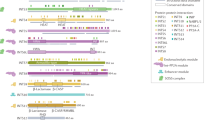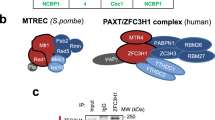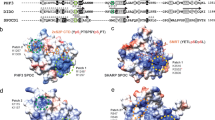Abstract
Phosphorylation of the RNA polymerase (Pol) II C-terminal domain (CTD) repeats (1-YSPTSPS-7) is coupled to transcription and may act as a 'code' that controls mRNA synthesis and processing. To examine the code in budding yeast, we mapped genome-wide CTD Ser2, Ser5 and Ser7 phosphorylations and the CTD-associated termination factors Nrd1 and Pcf11. Phospho-CTD dynamics are not scaled to gene length and are gene-specific, with highest Ser5 and Ser7 phosphorylation at the 5′ ends of well-expressed genes with nucleosome-occupied promoters. The CTD kinases Kin28 and Ctk1 markedly affect Pol II distribution in a gene-specific way. The code is therefore written differently on different genes, probably under the control of promoters. Ser7 phosphorylation is enriched on introns and at sites of Nrd1 accumulation, suggesting links to splicing and Nrd1 recruitment. Nrd1 and Pcf11 frequently colocalize, suggesting functional overlap. Unexpectedly, Pcf11 is enriched at centromeres and Pol III–transcribed genes.
This is a preview of subscription content, access via your institution
Access options
Subscribe to this journal
Receive 12 print issues and online access
$209.00 per year
only $17.42 per issue
Buy this article
- Purchase on SpringerLink
- Instant access to full article PDF
Prices may be subject to local taxes which are calculated during checkout






Similar content being viewed by others
Accession codes
Change history
26 September 2010
In the version of this article initially published online, accession code information was given incorrectly. The correct code is GEO series accession number GSE23960. The error has been corrected for the print, PDF and HTML versions of the article.
References
Phatnani, H.P. & Greenleaf, A.L. Phosphorylation and functions of the RNA polymerase II CTD. Genes Dev. 20, 2922–2936 (2006).
Buratowski, S. The CTD code. Nat. Struct. Biol. 10, 679–680 (2003).
Komarnitsky, P., Cho, E.J. & Buratowski, S. Different phosphorylated forms of RNA polymerase II and associated mRNA processing factors during transcription. Genes Dev. 14, 2452–2460 (2000).
Egloff, S. & Murphy, S. Cracking the RNA polymerase II CTD code. Trends Genet. 24, 280–288 (2008).
Gudipati, R.K., Villa, T., Boulay, J. & Libri, D. Phosphorylation of the RNA polymerase II C-terminal domain dictates transcription termination choice. Nat. Struct. Mol. Biol. 15, 786–794 (2008).
Akhtar, M.S. et al. TFIIH kinase places bivalent marks on the carboxy-terminal domain of RNA polymerase II. Mol. Cell 34, 387–393 (2009).
Kim, M., Suh, H., Cho, E.J. & Buratowski, S. Phosphorylation of the yeast Rpb1 C-terminal domain at serines 2, 5, and 7. J. Biol. Chem. 284, 26421–26426 (2009).
Kanin, E.I. et al. Chemical inhibition of the TFIIH-associated kinase Cdk7/Kin28 does not impair global mRNA synthesis. Proc. Natl. Acad. Sci. USA 104, 5812–5817 (2007).
Vasiljeva, L., Kim, M., Mutschler, H., Buratowski, S. & Meinhart, A. The Nrd1–Nab3–Sen1 termination complex interacts with the Ser5-phosphorylated RNA polymerase II C-terminal domain. Nat. Struct. Mol. Biol. 15, 795–804 (2008).
Hong, S.W. et al. Phosphorylation of the RNA polymerase II C-terminal domain by TFIIH kinase is not essential for transcription of Saccharomyces cerevisiae genome. Proc. Natl. Acad. Sci. USA 106, 14276–14280 (2009).
Jones, J.C. et al. C-terminal repeat domain kinase I phosphorylates Ser2 and Ser5 of RNA polymerase II C-terminal domain repeats. J. Biol. Chem. 279, 24957–24964 (2004).
Cho, E.-J., Kobor, M., Kim, M., Greenblatt, J. & Buratowski, S. Opposing effects of Ctk1 kinase and Fcp1 phosphatase at Ser 2 of the RNA polymerase II C-terminal domain. Genes Dev. 15, 3319–3329 (2001).
Ahn, S.H., Kim, M. & Buratowski, S. Phosphorylation of serine 2 within the RNA polymerase II C-terminal domain couples transcription and 3′ end processing. Mol. Cell 13, 67–76 (2004).
Kim, M. et al. The yeast Rat1 exonuclease promotes transcription termination by RNA polymerase II. Nature 432, 517–522 (2004).
Rondon, A.G., Mischo, H.E., Kawauchi, J. & Proudfoot, N.J. Fail-safe transcriptional termination for protein-coding genes in S. cerevisiae. Mol. Cell 36, 88–98 (2009).
Jimeno-Gonzalez, S., Haaning, L.L., Malagon, F. & Jensen, T.H. The yeast 5′-3′ exonuclease Rat1p functions during transcription elongation by RNA polymerase II. Mol. Cell 37, 580–587 (2010).
Meinhart, A. & Cramer, P. Recognition of RNA polymerase II carboxy-terminal domain by 3′-RNA-processing factors. Nature 430, 223–226 (2004).
Kim, M. et al. Distinct pathways for snoRNA and mRNA termination. Mol. Cell 24, 723–734 (2006).
Steinmetz, E.J. et al. Genome-wide distribution of yeast RNA polymerase II and its control by Sen1 helicase. Mol. Cell 24, 735–746 (2006).
Arigo, J.T., Eyler, D.E., Carroll, K.L. & Corden, J.L. Termination of cryptic unstable transcripts is directed by yeast RNA-binding proteins Nrd1 and Nab3. Mol. Cell 23, 841–851 (2006).
Thiebaut, M., Kisseleva-Romanova, E., Rougemaille, M., Boulay, J. & Libri, D. Transcription termination and nuclear degradation of cryptic unstable transcripts: a role for the nrd1-nab3 pathway in genome surveillance. Mol. Cell 23, 853–864 (2006).
Neil, H. et al. Widespread bidirectional promoters are the major source of cryptic transcripts in yeast. Nature 457, 1038–1042 (2009).
Morlando, M. et al. Functional analysis of yeast snoRNA and snRNA 3′-end formation mediated by uncoupling of cleavage and polyadenylation. Mol. Cell. Biol. 22, 1379–1389 (2002).
Lykke-Andersen, S. & Jensen, T.H. Overlapping pathways dictate termination of RNA polymerase II transcription. Biochimie 89, 1177–1182 (2007).
Venters, B.J. & Pugh, B.F. A canonical promoter organization of the transcription machinery and its regulators in the Saccharomyces genome. Genome Res. 19, 360–371 (2009).
Xu, Z. et al. Bidirectional promoters generate pervasive transcription in yeast. Nature 457, 1033–1037 (2009).
Tirosh, I. & Barkai, N. Two strategies for gene regulation by promoter nucleosomes. Genome Res. 18, 1084–1091 (2008).
Graber, J.H., McAllister, G.D. & Smith, T.F. Probabilistic prediction of Saccharomyces cerevisiae mRNA 3′-processing sites. Nucleic Acids Res. 30, 1851–1858 (2002).
Camblong, J., Iglesias, N., Fickentscher, C., Dieppois, G. & Stutz, F. Antisense RNA stabilization induces transcriptional gene silencing via histone deacetylation in S. cerevisiae. Cell 131, 706–717 (2007).
Houseley, J., Rubbi, L., Grunstein, M., Tollervey, D. & Vogelauer, M. A ncRNA modulates histone modification and mRNA induction in the yeast GAL gene cluster. Mol. Cell 32, 685–695 (2008).
Hongay, C.F., Grisafi, P.L., Galitski, T. & Fink, G.R. Antisense transcription controls cell fate in Saccharomyces cerevisiae. Cell 127, 735–745 (2006).
Ghazal, G. et al. Yeast RNase III triggers polyadenylation-independent transcription termination. Mol. Cell 36, 99–109 (2009).
Bolton, E.C. & Boeke, J.D. Transcriptional interactions between yeast tRNA genes, flanking genes and Ty elements: a genomic point of view. Genome Res. 13, 254–263 (2003).
Corden, J.L. Yeast Pol II start-site selection: the long and the short of it. EMBO Rep. 9, 1084–1086 (2008).
Luke, B. et al. The Rat1p 5′ to 3′ exonuclease degrades telomeric repeat-containing RNA and promotes telomere elongation in Saccharomyces cerevisiae. Mol. Cell 32, 465–477 (2008).
Schroeder, S.C., Zorio, D.A., Schwer, B., Shuman, S. & Bentley, D. A function of yeast mRNA cap methyltransferase, Abd1, in transcription by RNA polymerase II. Mol. Cell 13, 377–387 (2004).
Gilbert, W. & Guthrie, C. The Glc7p nuclear phosphatase promotes mRNA export by facilitating association of Mex67p with mRNA. Mol. Cell 13, 201–212 (2004).
Qu, X. et al. Assembly of an export-competent mRNP is needed for efficient release of the 3′-end processing complex after polyadenylation. Mol. Cell. Biol. 29, 5327–5338 (2009).
Rougemaille, M. et al. THO/Sub2p functions to coordinate 3′-end processing with gene-nuclear pore association. Cell 135, 308–321 (2008).
Carroll, K.L., Ghirlando, R., Ames, J.M. & Corden, J.L. Interaction of yeast RNA-binding proteins Nrd1 and Nab3 with RNA polymerase II terminator elements. RNA 13, 361–373 (2007).
Vasiljeva, L. & Buratowski, S. Nrd1 interacts with the nuclear exosome for 3′ processing of RNA polymerase II transcripts. Mol. Cell 21, 239–248 (2006).
Vasiljeva, L., Kim, M., Terzi, N., Soares, L.M. & Buratowski, S. Transcription termination and RNA degradation contribute to silencing of RNA polymerase II transcription within heterochromatin. Mol. Cell 29, 313–323 (2008).
Ghazal, G., Ge, D., Gervais-Bird, J., Gagnon, J. & Abou Elela, S. Genome-wide prediction and analysis of yeast RNase III-dependent snoRNA processing signals. Mol. Cell. Biol. 25, 2981–2994 (2005).
Raha, D. et al. Close association of RNA polymerase II and many transcription factors with Pol III genes. Proc. Natl. Acad. Sci. USA 107, 3639–3644 (2010).
Barski, A. et al. Pol II and its associated epigenetic marks are present at Pol III–transcribed noncoding RNA genes. Nat. Struct. Mol. Biol. 17, 629–634 (2010).
Chernyakov, I., Whipple, J.M., Kotelawala, L., Grayhack, E.J. & Phizicky, E.M. Degradation of several hypomodified mature tRNA species in Saccharomyces cerevisiae is mediated by Met22 and the 5′-3′ exonucleases Rat1 and Xrn1. Genes Dev. 22, 1369–1380 (2008).
Nagalakshmi, U. et al. The transcriptional landscape of the yeast genome defined by RNA sequencing. Science 320, 1344–1349 (2008).
Nieduszynski, C.A., Hiraga, S., Ak, P., Benham, C.J. & Donaldson, A.D. OriDB: a DNA replication origin database. Nucleic Acids Res. 35, D40–D46 (2007).
Schroeder, S.C., Schwer, B., Shuman, S. & Bentley, D. Dynamic association of capping enzymes with transcribing RNA polymerase II. Genes Dev. 14, 2435–2440 (2000).
Zhang, L., Schroeder, S., Fong, N. & Bentley, D.L. Altered nucleosome occupancy and histone H3K4 methylation in response to 'transcriptional stress'. EMBO J. 24, 2379–2390 (2005).
Chapman, R.D. et al. Transcribing RNA polymerase II is phosphorylated at CTD residue serine-7. Science 318, 1780–1782 (2007).
Acknowledgements
This work was supported by US National Institutes of Health grants GM58613 to D.B., GM066213 to P.M., GM083127 to D.D.P., GM072706 to J.H.G. H.K. was supported by US National Institutes of Health American Recovery and Reinvestment Act award 3R01GM063873-06S1 to H.K. We thank S. Hahn (Fred Hutchinson Cancer Research Center) and D. Eick (CIPSM Munich) for strains and antibodies, S. Chavez (University of Seville), S. Johnson, K. Brannan and S. Kim for valuable discussions, K. Bhatta for help with figures, A. Lee (Denver School of the Arts) and A. Roth (Denver School of Science and Technology) for data analysis and C. Wang and M. Covarrubias (City of Hope Functional Genomics Core) for array hybridization.
Author information
Authors and Affiliations
Contributions
H.K., D.D.P., D.S. and J.H.G. wrote software and carried out data analysis; B.E., D.L.B., W.L. and P.C.M. designed and carried out experiments. D.L.B., H.K. and P.C.M. wrote the paper.
Corresponding author
Ethics declarations
Competing interests
The authors declare no competing financial interests.
Supplementary information
Supplementary Text and Figures
Supplementary Figures 1–8, Supplementary Tables 1 and 2, Supplementary Methods (PDF 6469 kb)
Rights and permissions
About this article
Cite this article
Kim, H., Erickson, B., Luo, W. et al. Gene-specific RNA polymerase II phosphorylation and the CTD code. Nat Struct Mol Biol 17, 1279–1286 (2010). https://doi.org/10.1038/nsmb.1913
Received:
Accepted:
Published:
Issue Date:
DOI: https://doi.org/10.1038/nsmb.1913



